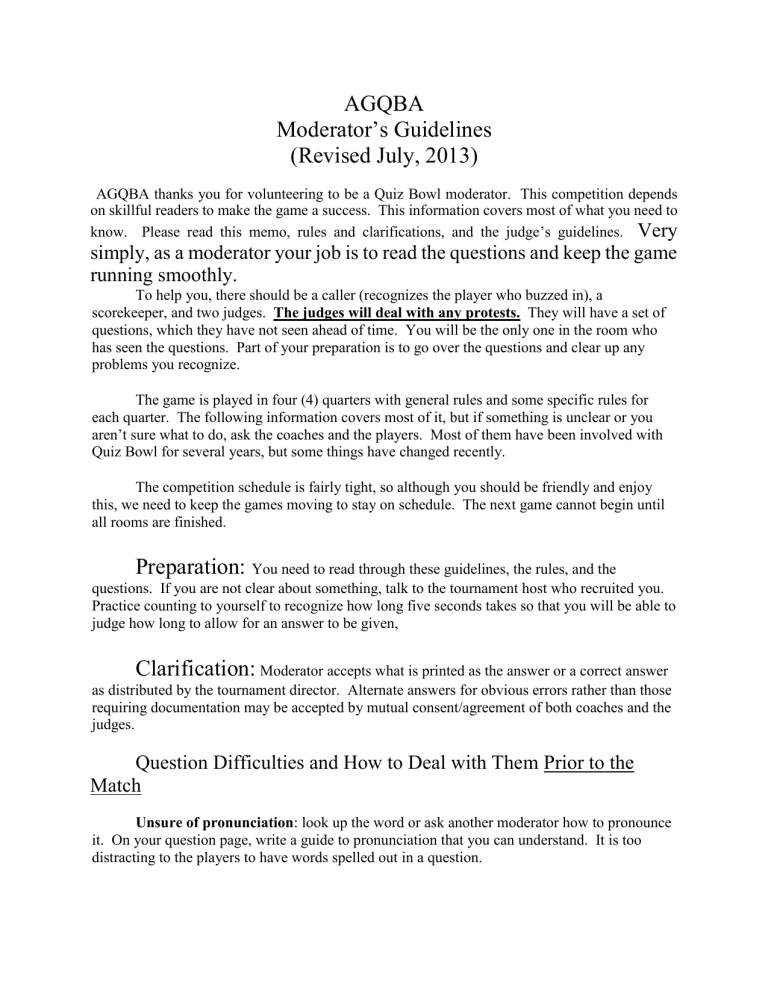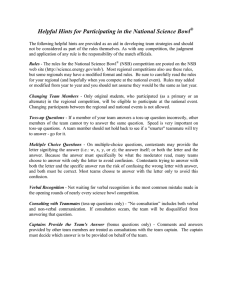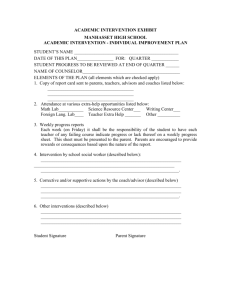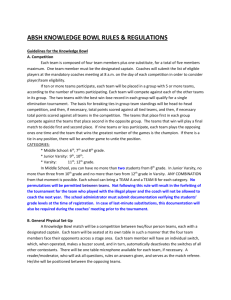Quarter Rules

AGQBA
Moderator’s Guidelines
(Revised July, 2013)
AGQBA thanks you for volunteering to be a Quiz Bowl moderator. This competition depends on skillful readers to make the game a success. This information covers most of what you need to know. Please read this memo, rules and clarifications, and the judge’s guidelines.
Very simply, as a moderator your job is to read the questions and keep the game running smoothly.
To help you, there should be a caller (recognizes the player who buzzed in), a scorekeeper, and two judges. The judges will deal with any protests.
They will have a set of questions, which they have not seen ahead of time. You will be the only one in the room who has seen the questions. Part of your preparation is to go over the questions and clear up any problems you recognize.
The game is played in four (4) quarters with general rules and some specific rules for each quarter. The following information covers most of it, but if something is unclear or you aren’t sure what to do, ask the coaches and the players. Most of them have been involved with
Quiz Bowl for several years, but some things have changed recently.
The competition schedule is fairly tight, so although you should be friendly and enjoy this, we need to keep the games moving to stay on schedule. The next game cannot begin until all rooms are finished.
Preparation:
You need to read through these guidelines, the rules, and the questions. If you are not clear about something, talk to the tournament host who recruited you.
Practice counting to yourself to recognize how long five seconds takes so that you will be able to judge how long to allow for an answer to be given,
Clarification:
Moderator accepts what is printed as the answer or a correct answer as distributed by the tournament director. Alternate answers for obvious errors rather than those requiring documentation may be accepted by mutual consent/agreement of both coaches and the judges.
Question Difficulties and How to Deal with Them Prior to the
Match
Unsure of pronunciation : look up the word or ask another moderator how to pronounce it. On your question page, write a guide to pronunciation that you can understand. It is too distracting to the players to have words spelled out in a question.
How to Read a Formula: Chemistry or math/science– again, ask another moderator or an expert in that subject to help you write it out as it should be said.
You Think an Answer Given on the Page is incorrect or that there is an Equally
Acceptable Answer : research it, and contact the state director with your concerns so it can be determined if this information needs to be changed prior to the tournament for all sites. Each moderator should have the same acceptable answers when competition begins.
There will be a moderator’s meeting the day before the tournament, or in some cases the day of competition, to go over any problems that were found.
General Guidelines and Rules
Buzz, Recognition, and answers: As a question is being read, players can buzz in at any time.
When you hear a buzzer, STOP! Mark where you stopped.
If you prefer to recognize the players rather than using a caller, that is fine. The caller should say the school name and player name before the player begins to answer. If the player does not wait, rule the answer incorrect “because you must wait to be recognized.”
Clarification: After the recognition of the player who has buzzed in to answer, no further prompting of “answer please” will be given by the moderator. A five-second interval has been allotted for the answer.
If the answer is correct, as a courtesy to the audience, the moderator should read the remainder of the interrupted question. Then go on to the next question.
If the answer is not correct, give the other team a chance to answer . If the answer was incorrect and five seconds have elapsed, immediately prompt the other team for an answer.
If the question was not completed and the first team answers incorrectly, the question will be completed and the opposing team will be given an opportunity to answer. Allow that team 5 seconds to answer. Moderators may use discretion in repeating interrupted questions. They do not have to ask for it to be finished. A player must still buzz in and be recognized.
On your paper, mark which team got the points or if neither team did. This helps to double check the score.
If you forget to turn the question over to the second team, give them a make– up question from the extras. Watch carefully for conferring on these toss– up questions by the second team. In these situations where the second team has the question all by itself, students have a tendency to look to one another or signal in some way as if to say,
“Are you going to get this one?”
Questions about Acceptable Answers
Pronunciation: If a player has difficulty pronouncing a word, be kind in your judgment, especially on foreign words. This is particularly a problem in names of people and places.
Listen for extras letters or syllables in pronunciation; allowing this leaves room for challenges.
Ask the judges if the answer is acceptable if you have doubts.
Mispronunciations: Simple mispronunciations should not be deemed incorrect answers. Some leeway must be given to students with speech and hearing difficulties, as well as speakers for whom English is a second language. In addition, some students may have only encountered some words in print, and never may have heard them pronounced. Pronunciations that are phonetically plausible should be acceptable. An answer is incorrect if extra syllables are added which cannot be accounted for phonetically, or if the answer given is another actual word that cannot be formed by the letters in the answer. EXAMPLE: Richard Wagner should be accepted as RICHard WAGner, even though his name is pronounced RiCARD VOGner, but the
Awful Tower should not be accepted for the Eiffel Tower, nor should SEB-ER-REE-US be accepted for Cerberus (SIR-BUR-US).
More than one answer: If a player buzzes in early and anticipates the rest of the question, he may give a multi– part answer as long as all parts are correct and the required answer is given.
No long rambling or fishing expeditions for answers will be allowed. Challenges involving multiple answers should be dealt with using the general rules.
Clarification: Moderators, remember if a student gives a partially correct answer but you need more detail, you must say “be more specific” elicit the additional information to determine if his answer is correct or not. You do not just pause and hope he will give additional information.
Clarification: Computational math/science answers must be stated in lowest terms with the specific unit of measurement given with the answer.
Timing
After the question is completed, allow five seconds for players to buzz in. Once the answer given by the first team is deemed incorrect and the question has been completed, the second team has only five seconds to signal. If the question was interrupted, finish the question for the other team. Allow that team 5 seconds to answer. The only exception is math/science calculation questions; for those allow twenty seconds . If the question involves a math/science calculation, alert the players before beginning the question by saying, “Math/science question calculation
” or “Pencil and paper ready?”
BE
VERY CAREFUL TO BE CONSISTENT IN ENFORCING THE TIME LIMITATIONS.
Clarification: If a math/science question has been interrupted and the team buzzing in early misses the question, the second team is given its full twenty seconds to buzz in and answer after hearing the completed question. (July, 2011)
Consultation
Consultation is allowed only on bonus and 60– second rounds. If teams talk or exchange notes during any other question, it must be ruled incorrect or not turned over because of consultation. Really watch for this on math/science problems; players are very tempted to look at each other’s papers.
Tie
At the beginning of the 60– second round, flip a coin to decide who goes first. At the end of the game, there are five tie-breaking questions. If there is still a tie after the five questions, there is a sudden death situation. A question must be answered to break the tie.
Conduct
Good sportsmanship must be maintained by players and coaches. If you or the judges feel a team is out of line, give it a warning. If the team does not respond courteously and fairly, you may stop the game and call in the tournament director for consultation. Do not let a team or coach bully you.
Challenges
Challenges regarding answers to questions can be lodged only by the team’s coach
, not the players. Challenges must be lodged at the end of each quarter except for the second quarter
(see specific rules for the second quarter). If a coach fails to follow the outline challenge procedure, the appeal will not be considered. Some type of hand signal between players and coach to indicate the need for a conference should be worked out prior to the competition.
Team-coach conferences will be allowed at the end of each quarter.
Clarification: Teams with more than one coach may send only one coach to present a challenge to the judges. ONE COACH PER CHALLENGE (August, 1997). Players, other participants, or spectators may not speak to the judge/s unless the judge/s specifically ask them to contribute to the discussion. (July, 2002).
Quarter Rules
First Quarter
: (Twenty toss-up questions worth 10 points each.) Players must buzz in, no consultation. You may read the question number if the coaches wish you to do so .
Challenges must wait until the end of the quarter . Procedural challenges must be lodged immediately upon violation of a rule. The judges deal with these challenges.
Second Quarter:
Toss-up (same as first quarter), followed by a four-part bonus question. The team that correctly answers the toss-up question gets the bonus. Each part of the bonus question is worth five points . In this quarter only, a challenge may be made after the toss-up. Do not ask for challenges, but pause to allow the coach a few seconds to challenge.
See the rules for dealing with challenges. This prevents a bonus question from being asked and answered on a toss-up question that may be challenged, thrown out, or ruled incorrect/correct.
The answers for bonus questions must be given by the captain or his designee, but team consultation is allowed on the bonus questions. Ask the captain to look at you when giving the answer. During the Bonus Round, the captain of a team may designate another active player on his/her team to answer a specific question. The captain must designate by name who will give the answer. Then that person would answer that particular question. There would need to be a verbal designation for each answer, not one designation for the whole Bonus Round.
Read the bonus introduction, if there is one. For four separate questions, read the first one, give five seconds (20 for math/science calculations) to consult, then “answer, please.”
Answers must be given immediately after you request them.
If the bonus question is a list, such as “list the first four books of the Old Testament,” read the question and then allow twenty (20) seconds to give the entire answer. Use the timer or a watch. Prompt the captain when 15 seconds has passed, “five seconds left.” The captain must have started the answer before 20 seconds expire. If he is in the middle of a list when the buzzer sounds, accept the answer if he does not pause . If the answer is not given in a continuous stream, the parts given after a pause are not accepted if time has expired . Do not ask for the answer after time has expired; be consistent. Only the first four answers will be accepted.
OF A
On the 4-part bonus questions, NEVER GIVE A CORRECT ANSWER TO ANY PART
QUESTION UNTIL ALL FOUR PARTS HAVE BEEN ASKED AND ANSWERED BY THE
TEAM!!!.
The bonus round ends after the four bonus sets have been read or you have read ten second quarter toss-up questions. If they did not get enough toss-ups right to get a chance at all four bonuses, the quarter is still over and play moves into the third quarter.
Third Quarter:
After any challenges from the second quarter have been dealt with and the score has been announced, READ THE THREE CATEGORIES AND
INTRODUCTIONS FOR THE
THIRD QUARTER. THEN teams may confer with the coach. After conferring with the coach, the team with the lower score chooses first from the three sets of 10-related questions. The second team then makes its selection of category. Then both teams make their substitutions and play begins.
Consultation of team and coaches may take no longer than one minute and must occur at the team table. Teams that take longer than the allotted time may lose their choice. Judges will be the official timers for this consultation. If a team does not make a choice in the allotted time, the judges will choose a category for the team. Judges’ decisions will be final. (July, 2006)
ALL ANSWERS MUST BE GIVEN BY THE CAPTAIN OR A DESIGNEE OF THE
CAPTAIN. During the 60– Second Round, a team may designate a separate captain for its initial category and for the bounceback. The designated captain may then designate another active player on his/her team to answer a specific question. The captain must designate who will give the answer. Then that player would will answer that particular question. (July, 2002)
Read the introduction, and then tell the timer to start the clock with the reading of the first word of the first question.
Read the questions quickly . DO NOT READ THE
NUMBERS.
Teams may consult, but the answer must come from the captain or his designee.
If the answer is correct, say “Yes” and go on. If it is incorrect, say “No” and move on. The captain may say “pass” and you go to the next question.
It is easier on the scorekeeper, teams, coaches, and spectators if you say “yes” or “no” rather than “correct” or “incorrect”. Please practice this ahead of time and be consistent. The
“Yes/No” answer also takes less of the 60– second time allotted for this round.
Due to the recent rule change concerning the 60– second round, team captains do not have to respond to the question. They may legally “sit” on a question rather than turning over it or the remainder of the category to the other team. In such a case, the team may simply allow time to run out. They are also allowed to say “Stall” to end the round.
Clarifications: If the captain gives an answer that needs to be more specific, such as a name, quickly say “more specific.” If you are unsure on any answer, say “no” and go on. After time has expired, you may ask for clarification of an answer. Let the judges, players, and coaches know why you are asking. Ask the judges what they heard. Do not accept challenges at this time.
Teams cannot go back to questions they passed even if they have time remaining.
If the captain is in the middle of a word when the timer sounds, accept the answer. No answers may be accepted if they start after the buzzer.
Any questions missed or passed are turned over to the other team. If the last question read was not missed or passed, it is not turned over.
There is no prompting of “answer please” during 60–second round.
Consult with judges, scorekeepers, and coaches: “I have #4, #6, and so on to turn over. Is that right?” Then the other team has a chance to answer. Read the question and allow no more than five seconds for a response. You do not have to prompt them; they should have the answer ready.
When the second team is giving bounce-back responses to those questions missed by the first team, again NEVER EVER GIVE ANY CORRECT RESPONSES UNTIL ALL ITEMS
MISSED BY THE FIRST TEAM ARE ASKED OF THE SECOND TEAM AND THEY HAVE
RESPONDED TO ALL ITEMS.
After both teams have had a chance, read the correct answers to the ones that were missed by both teams.
If there is problem in this round, use the 11 th
question from the category list or a question from the category that was not picked.
Fourth Quarter:
Same as the first quarter. Begin with the question labeled for the
Fourth Quarter. Toss-up not used in the Second Quarter DO NOT carry over.
Ask for challenges before announcing the final score. After all challenges have been settled, announce the final score. If there is a tie, see the general rules. If the match results in a tie, you give five (5) toss-up questions, not three (3) as printed on the score sheet. These points only break the tie to declare a winner– they are not added to the final score of the match.
The next game will not begin until all games for the round are finished. Keep the questions with you and secure at all times. Turn in all questions to the tournament host at the end of the tournament.
The entire Quiz Bowl organization committee, hosts, coaches, and players thank you for taking part in this tournament. Quiz Bowl couldn’t happen without dedicated volunteers, especially moderators.
Moderator Script
Most important – Don’t stress. Have fun. The coaches will be glad to help.
The rules are in the file right there with you. Don’t be afraid to LOOK UP A
RULE. Project your voice to the back of the room. Everyone needs to hear you.
Call on each student before they answer or designate who will (a judge or scorekeeper).
Math/science – say the equations SLOWLY; the players must write them down.
In the Beginning
“This is Game ___ of our tournament with (school name) playing (school
name). Let’s make sure I can correctly pronounce all your names (say them all).
And let’s have a buzzer check.”
“Please no one leave the room until the score keeper returns from delivering the game forms to the Record Room.”
“Let’s begin Round 1 – 20 toss-up questions for both teams.”
At the End of Round 1
“This is the end of Round 1. Are there any challenges at this time? (Deal with any challenges presented – 5 minutes) Our score is... (Let the scorekeeper read the score) Does everyone concur? (Check with the coaches; they keep score too.)
Are there any substitutions?”
At the Beginning of Round 2
“Let’s begin Round 2. We have 10 toss-up questions to determine which team gets the bonus question. Coaches, any challenge of a toss-up question should come after each toss-up question – not at the end of the Round. Any challenge of a Bonus
Question must be made at the end of the Round. Let’s begin.”
When a Team gets a Toss-up Correct
“(School name
) gets the first (second, third, or fourth) 4 part bonus question.
Who is your captain? Your answers will come through him/her.”
After Each
Bonus Question
"And back to the Toss-up Questions for both teams.”
At the End of Round 2
“This is the end of Round 2. Are there any challenges at this time? (Deal with any challenges presented – 5 minutes)
Our score is…
( Let the scorekeeper read the score) Does everyone concur? (Check with the coaches; they keep score too.)
Are there any substitutions?”
At the Beginning of the Lightning Round
“With the score ___ to ___ (school with the fewer points) gets first choice of the
Lightning Round possibilities. Your categories are as follows: (Read the titles and descriptions for all three Lightning Round categories.) You have 1 minute to
confer. Substitutions will be made after both teams have made their selections.”
After 1 minute get the decisions of both teams. While they are making their substitutions, write the names of the schools at the top of their respective
categories. Write a (right) or X (wrong or pass) next to the answers as they go.
DO NOT SAY THE NUMBERS OF THE QUESTIONS AND READ AS QUICKLY
AS POSSIBLE. REMEMBER TO SAY
“YES” OR “NO”, NOT “CORRECT” OR “INCORRECT”.
“(School name) will have 1 minute to answer these ten questions on (re-read the title and description).
Time begins after I finish reading the first word of number 1. Here we go.”
If a team says “STALL” after hearing a question, that question does NOT get thrown over to the other team.
“(Other team) gets the Bounce Back on questions (give the numbers of the ones the first team missed).”
REPEAT THE PROCESS FOR THE OTHER TEAM.
At the End of the Lightning Round
“This is the end of Round 2. Are there any challenges at this time?
(Deal with any challenges presented – 5 minutes) Our score is… (Let the scorekeeper read the score) Does everyone concur?
(Check with the coaches; they keep score too.)
Are there any substitutions?”
At the Beginning of Round 4
“We have 20 Toss-up Questions left for both teams for a possible 200 points.
It’s still anyone’s game.” (Always good to encourage)
When you get to #40, you may wish to begin saying the numbers of the questions: it builds suspense toward the end.
At the End of the Game
“Are there any challenges?
(Deal with any challenges) Can we have the final score please?
(Let the scorekeeper read the score.) Does everyone concur?
Congratulations
_____ ! Great game! We need the coaches’ signatures on the Official
Scoresheet and the All-Tournament Tally Sheet.”
Send the scorekeeper to the Record Room with the Official Scoresheet and the
AllTournament Tally Sheet.
Don’t let anyone leave until the scorekeeper comes back to the room.






